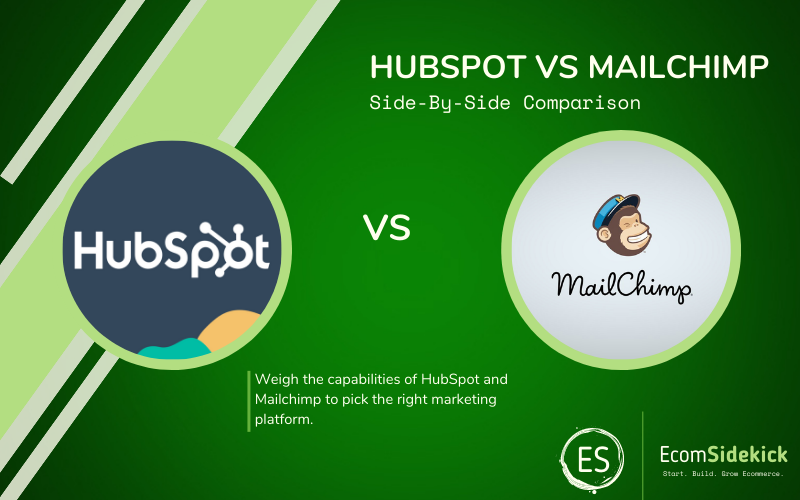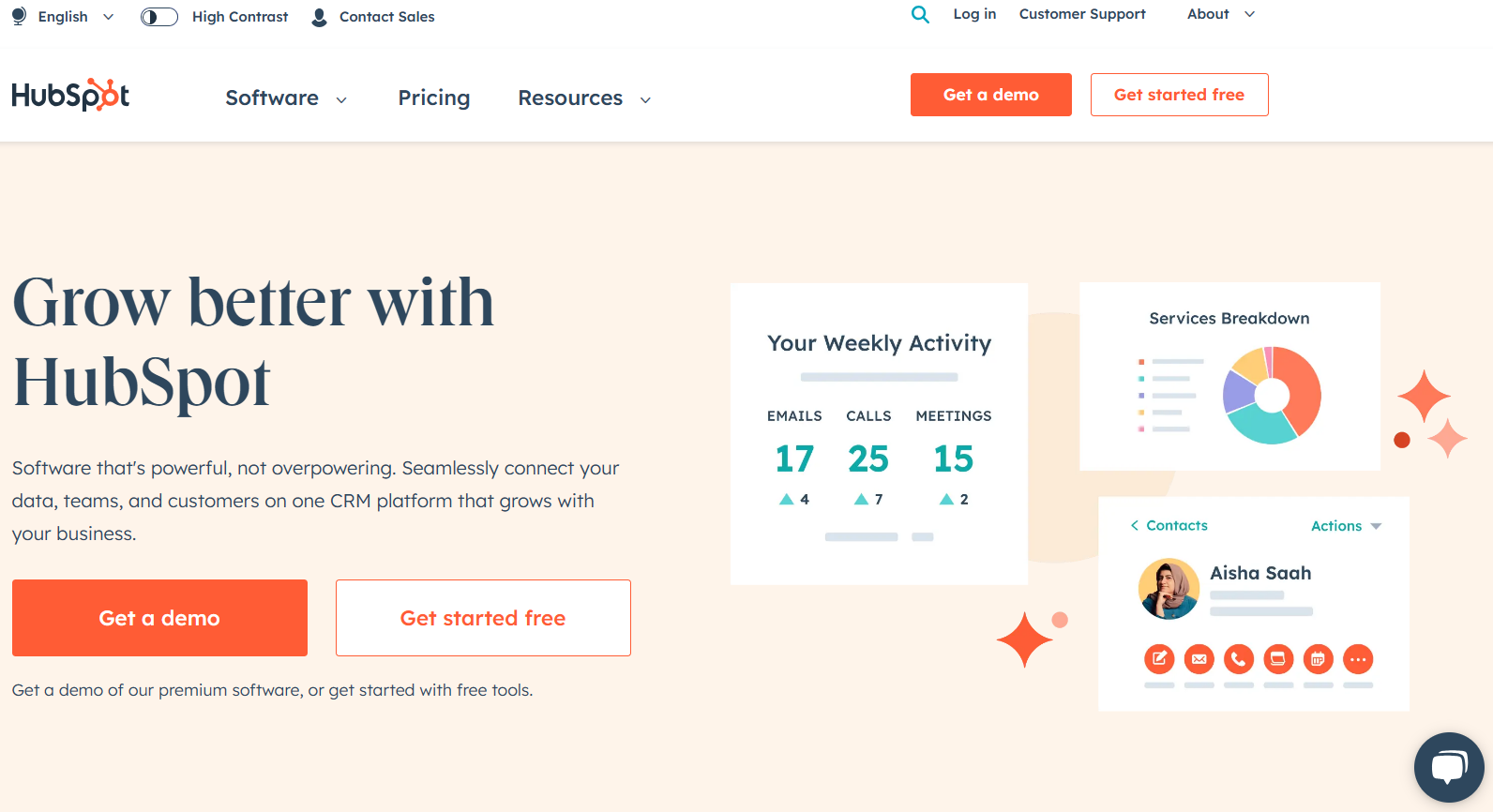If you are running a business and want to attract visitors, a marketing automation platform is a must. Marketing and sales are not easy tasks, especially in today’s rapidly growing world. No business can run efficiently without communicating with the customer. In any case, email marketing is one of the best ways to boost customer interaction.

It can be hard to keep track of everything happening when you’re working to grow a business. You want your marketing efforts to be efficient and effective, but you don’t want to manage them every other hour. It is also necessary to keep your customers aware of all your packages and deals.
Hence, an efficient marketing tool that manages all your emails should be highly prioritized. This article will compare Hubspot vs Mailchimp to help you decide which is better-suited to your needs.
About Hubspot

Hubspot is a tool used by different businesses to increase their marketing. It provides a complete platform to increase your interactions with your customers. For this, it combines different marketing tools. For instance, Hubspot can be used for automatic emailing.
Hubspot has a marketing CRM. With CRM, you can see whether or not your customers are interacting with your content and landing pages. Moreover, you can know what they’re clicking on when they interact with your site. You can also learn the region your customer belongs to. You’ll also find out what kind of information about them is being shared with other companies—and whether or not that data is being used correctly.
With HubSpot’s features, you can manage all your website needs from one place and get the best return. It includes an easy-to-use dashboard so that you can track metrics. You can also track who has signed up for your newsletter. Furthermore, you can understand who has downloaded your app in the past week or month.
HubSpot goes well beyond email. For example, if you have a blog and need help with SEO or social media optimization, then HubSpot can provide that and create custom landing pages for your ad campaigns. It also has tools for creating landing pages and forms so that you can easily manage all your customer interactions in one place.
HubSpot is a tool that helps businesses of all sizes. Its email marketing software can get more out of its outreach campaigns and take advantage of other marketing channels such as social media, webinars, and more. Additionally, its integrated marketing platform is easy to use and will have you up and running in no time.
HubSpot is an excellent choice for small-to-medium businesses because it has many features that allow them to create content around customer needs and engage with prospects through email marketing.
Pros
Marketing CRM allows you to see user engagement
Provides SEO or social media optimization
Beneficial for businesses of any size
CONS
No refunds upon cancellation
About Mailchimp

Mailchimp is a very popular email marketing service. It has over 100 million users. The company was founded in 2001 as a small software company providing customer support for an early web development platform. Since then, it has grown into an industry leader that offers an extensive range of features for managing customer communications.
The simplest definition of Mailchimp is that it is a marketing platform just like Hubspot; however, the features vary. The main specialty of Mailchimp is its emailing tool. Mailchimp serves as the best email marketing tool for businesses.
Mailchimp provides a suite of services for email marketers. It includes email templates, list management, integration with third-party software, and more. Mailchimp offers several different types of accounts, including a free account. This account allows users to create up to 10 campaigns per month. A paid account allows up to 3,000 subscribers, and a list-building plan allows up to 500 contacts per month.
Mailchimp is an easy-to-use platform. You can easily operate all the tools even if you are a non-tech person. It provides an easy interface for email marketing.
Pros
User-friendly and easy for beginners
Provides a top-rated email marketing tool
Includes various services, including email templates, list management, and more
CONS
Could have more integrations
Similarities Between Hubspot vs Mailchimp
After understanding both platforms, it is to note that both platforms provide excellent email marketing. However, the difference lies in the features offered by both platforms.
Design
There aren’t many flaws when creating marketing campaign designs with either tool. Also, both tools have drag-and-drop editors, which makes it easy to move design elements or change themes with a click.
Email Marketing Software
With email marketing software like Mailchimp and Hubspot, you can create beautiful emails that are easy to edit and update—and they’ll also look great on mobile devices.
Both Provide Free Templates
Attracting customers is the key to a marketing campaign. Undoubtedly, visuals and optics play an important role in this. Hence, you cannot deny the importance of an excellent template and design.
Tracking Audience
Analytics are a necessary part of marketing. You cannot carry out the right marketing without understanding your customers. To carry out successful marketing, you should know the interests and disinterests of your audience.
Both platforms have excellent performance. You can track your audiences’ activities through Mailchimp and Hubspot.
HubSpot |
| |
Mailchimp |
|
Differences Between Hubspot and Mailchimp
Variety of Templates
Mailchimp has an extensive library of templates (including free ones) and allows you to share your designs through their marketplace. You can also create custom templates if needed. On the other hand, Hubspot lacks a marketplace for its users but offers many pre-built templates customized for each type of company.
Tracking Activity
However, Mailchimp has more tools for tracking the activity of your audience. On the other hand, Hubspot is better at giving recommendations. The platform has special AI tools that recommend different techniques to attract your customers. Moreover, the insights are displayed in a more emphasized way by Hubspot. Hence, you can count on it if you want to view insights from your audience.
Campaign Optimization
The bounce rate of your email is important. When you compare HubSpot and Mailchimp, it turns out that the real difference between the two services is how each can help you optimize your campaigns.
Mailchimp can help you see if there are any issues with your content or design that might be contributing to those bounces. However, it doesn’t tell you why people are bouncing. If Mailchimp had that data, it could help you identify what part of your email was doing better than others. Moreover, it would tell changes in future campaigns that can reduce bounces.
HubSpot provides detailed information about the type of bounce that it was. Because HubSpot users have this information, they know what to do differently in the future. They’re able to fix their mistakes before they happen again.
HubSpot Analytics provides this clarity by telling you exactly what bounce rate your email has—so you can ensure that your next email will succeed where your last one failed.
Social Media Accessing
Mailchimp’s integration with Facebook and Twitter allows you to post updates to those platforms directly from your email campaign, which is a nice feature. However, it might not be cost-effective if you have a larger list for your Google ads. Moreover, it provides excellent functionality to manage Google Display Ads.
Mailchimp’s integration with Facebook, Twitter, and LinkedIn is pretty basic. It lacks key features such as analytics and tracking pixels. Also, this application does not offer the option to manage multiple SMTP addresses (although there is a workaround).
HubSpot has several advanced features that allow users to engage in deeper conversations with their customers through social media. For example, users can use the system to set up polls, ask questions and collect feedback on products without having to give away any personal information about themselves or their company. Moreover, with Hubspot, you can manage your contact database, which can help your sales team.
HubSpot’s approach to integrating email marketing is more comprehensive than Mailchimp’s; however, this platform is more expensive than Mailchimp.
Our Pick
In our opinion, Hubspot is the clear winner in the battle between Hubspot vs Mailchimp. Not only is Hubspot suitable for businesses of any size, but it contains email marketing software that gains significantly more outreach than its competitors. Moreover, Hubspot’s marketing CRM clearly displays whether or not customers are interacting with your content, giving business owners an opportunity to increase engagement.
Final Thoughts
The choice of one platform out of Mailchimp and Hubspot entirely depends on your marketing strategy. The choice is dependent on what marketing tool you prioritize.
For instance, if you want an excellently designed template, you can go for Mailchimp, which has 100 distinct custom-coded email templates. However, if analytics is your priority, you can choose Hubspot over Mailchimp.
Before selecting a marketing platform, decide on your digital marketing solution first. It is necessary to learn about your audience and customers first. Kids will be more attracted to colors and designs if your customers are kids.
Hence, you can go for the best and most vibrant templates. However, if your customer wants daily business updates, you should focus more on other flexible marketing tools. Both tools are excellent for carrying out marketing campaigns. Good luck!
Frequently Asked Questions
What Is Hubspot, and How Does It Compare to Mailchimp?
HubSpot and Mailchimp are both popular marketing platforms, but they offer different features and functionalities. HubSpot is an all-in-one inbound marketing and sales platform that includes email marketing, CRM, automation, content management, and more. Mailchimp, on the other hand, is primarily an email marketing platform with additional marketing tools.
Which Platform Is More Suitable for Email Marketing Campaigns and Newsletters?
While both platforms offer email marketing capabilities, Mailchimp is particularly renowned for its user-friendly interface and focus on creating visually appealing email campaigns and newsletters.
How Do the Costs of Using Hubspot and Mailchimp Compare?
HubSpot is known for its comprehensive marketing suite, and pricing can be higher compared to Mailchimp. Mailchimp offers various pricing plans based on the number of subscribers and features needed, including a free plan for smaller lists.
Can Both Platforms Handle Marketing Automation and Workflows for Email Campaigns?
Yes, both HubSpot and Mailchimp offer marketing automation features. HubSpot’s automation capabilities are part of its broader inbound marketing and CRM platform, while Mailchimp provides automation for email marketing specifically.
What Level of Customization and Design Control Do Users Have On Hubspot and Mailchimp?
Mailchimp provides users with a user-friendly drag-and-drop email builder, allowing for easy customization and design control. HubSpot offers a range of customization options, but its focus is more on inbound marketing strategies and CRM functionality.
Paul Martinez is the founder of EcomSidekick.com. He is an expert in the areas of finance, real estate, eCommerce, traffic and conversion.
Join him on EcomSidekick.com to learn how to improve your financial life and excel in these areas. Before starting this media site, Paul built from scratch and managed two multi-million dollar companies. One in the real estate sector and one in the eCommerce sector.



